Psoriasis (translated from the Greek "psora" - "skin disease, scabs") is a chronic pathology of a non-infectious nature, also known as scaly lichen, which mainly affects the skin on the knee and elbow joints, lower back and head. There is also psoriasis of the joints, bones, nails, external genitals, and internal organs, but these forms are rarely diagnosed. The pathology is difficult to cure, so it is imperative to consult a doctor when the first symptoms, red rashes appear.
Symptoms
Stearin stain
The first sign of psoriasis, which is part of the triad of pathological symptoms. It is characterized by increased peeling after scraping the affected surface with a spatula. In the course of time there is a separation from the papules of the silver-white scales. Their removal is not difficult, since they loosen and adhere weakly to the psoriatic papule. The surface of neoplasms (rashes) turns white, and the particles crumble and resemble chips.
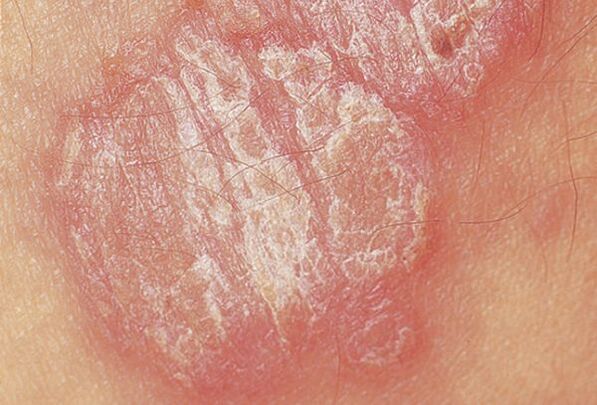
The first phenomenon of the triad is explained by the development of parakeratosis (malfunction of the epithelium, which leads to a violation of the formation of the stratum corneum). To combat deviations at the initial stage, local non-hormonal agents (creams, ointments) are used.
Terminal film
It is characterized by the removal of a thin layer of tissue from the papules, which has a glossy structure and looks like polyethylene. After removing dried flakes, it can be easily separated by impact (pressure, friction, etc. ).
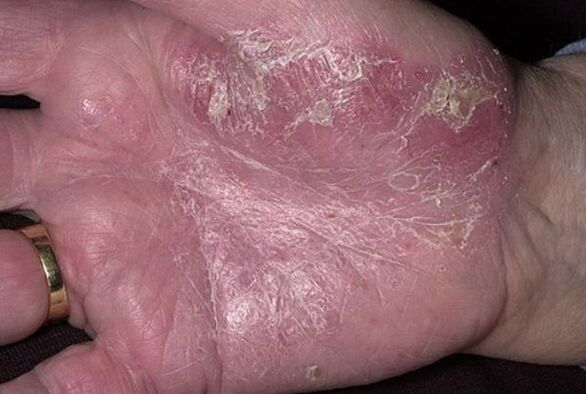
The final film is the last layer that is removed from the skin. Further scraping leads to the final stage of the triad - drip bleeding.
At this stage, medicinal herbal baths, medicines with antiallergic effects and natural ointments (without corticosteroids and hormones) are used.
Precise bleeding
After removing the final film, the affected area of skin drips (auspits symptom or "bloody dew") and an accelerated growth of neoplasms, sometimes the size of a pea and referred to as lenticular, is noted. In some cases, the papules grow to the diameter of a small coin and differentiate as nummular. As the disease progresses, their growth increases, and when they are combined, psoriatic plaques are formed.
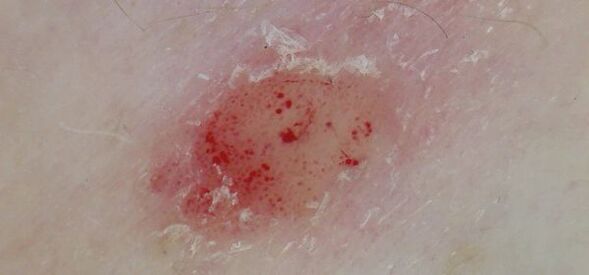
Retinoids, immunomodulators, anti-inflammatory drugs, and physical therapy are used for treatment.
Other
The disease can be recognized by other characteristic signs, the main 4 of which are:
- The edge is red, not covered with scales that form around the papules.
- Small rashes are visible on a clean area of skin (usually occurs before the psoriasis progresses).
- A symptom that helps differentiate psoriasis from seborrheic dermatitis is characteristic of the active stage of the pathology. It is accompanied by the appearance of papules with clear borders on the scalp, which is not the case with seborrheic dermatitis.
- A light, shiny edge of skin appears around the formation. The symptom is typical of the regression stage of the disease and occurs when the papules disappear.
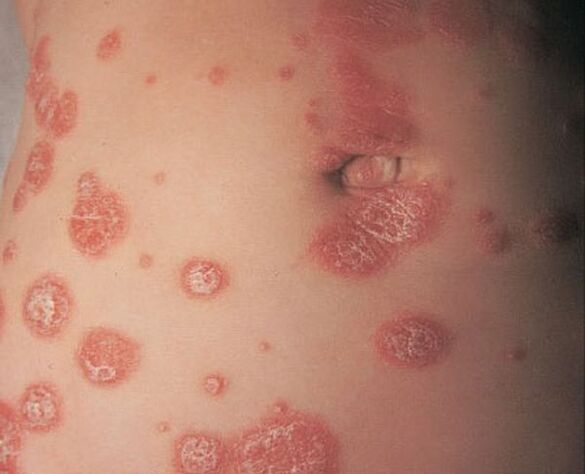
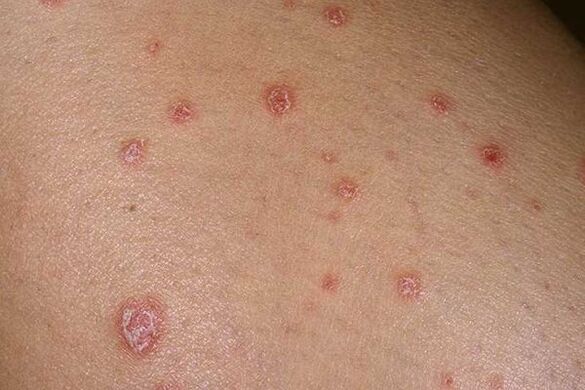
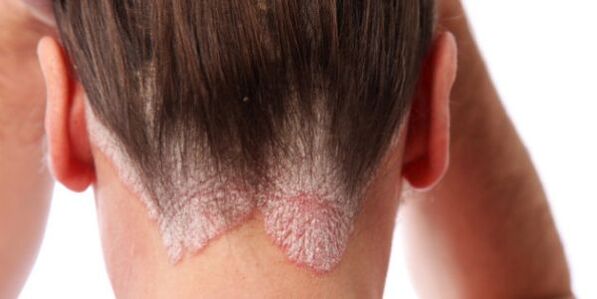
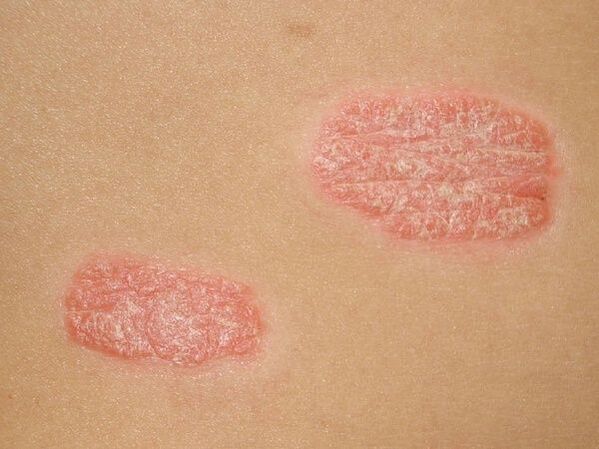
How does it look like
In most cases, the onset of the pathology is imperceptible: at an early stage, psoriasis affects small areas of the skin, mainly on the bends of the limbs, head and along the hairline.
Attention!Initial manifestations occur at the site of constant mechanical skin irritation, for example, where the clothing rubs and squeezes.
Common symptoms:
- Itching;
- excessive dryness of the skin;
- Peeling of pathological elements;
- general deterioration in health (weakness, lethargy, fever).
There are 3 stages of development of pathological papules:
- Progressive.The appearance of a rash of light pink color, surrounded by a rich, slightly vague border. In the center of the papules, the skin peels off, giving the formations a white color. At this stage, the rash may appear on the site of scratches, skin lesions, bites, cuts, punctures, or burns.
- Stationary.It starts 1-4 weeks after the onset of the disease. New plaques do not appear, old ones get a light color, the intensity of the peeling decreases.
- Regressive.The color of plaques and papules fades, their infiltration decreases, and the formations dissolve. The average duration of the decay period is 2 to 6-8 months.
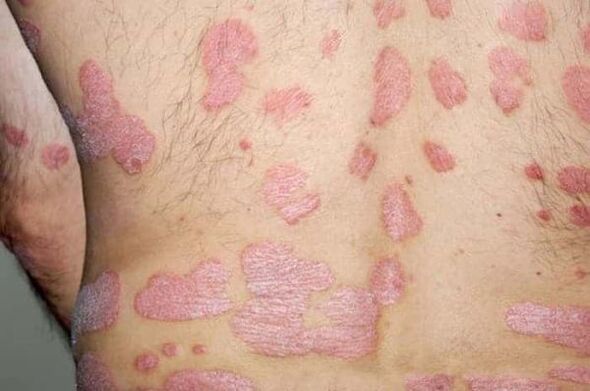

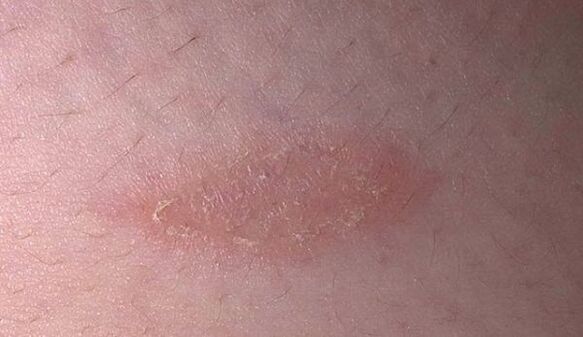
Disease symptoms depending on the type:
- plaque(common or vulgar). The most common type of pathology. On different parts of the body (more often on the elbows, knees, head), oval or round plaques with a red hue appear, covered with silver-white scales on top.
- Seborrheic.It mainly occurs on the scalp. It manifests as peeling and itching, spreading to the area behind the ears and the skin along the hairline.
- pustuleThe type is considered to be the most severe form, develops quickly and affects large areas of the skin. Painful rashes appear on the body, which are accompanied by a local increase in temperature, weakness, headache and diarrhea. Vesicles filled with exudate soon form in the lesions. In the future, the spots will progress, fuse with each other and form large lesions on the body.
- Intertriginous.Typical of children, accompanied by bright red papules with a slight peeling (may not be present).
- Exudative.The affected areas of skin not only peel off, but also form moist, yellowish crusts on the surface of the plaques.
- Psoriatic erythroderma.Red plaques with silver, yellow, or white scales can be seen throughout the body. It is accompanied by an increase in the lymph nodes, an increase in body temperature. In the future, the formations merge into large spots that cause irritation and itching.
- Psoriatic arthritis.It is associated with a "joint syndrome" in which the skin around the joints (on the wrists, phalanges of the fingers, the spine, etc. ) is affected and if action is not taken in a timely manner, the disease affects the joints.
- tearaccompanied by severe rashes, consisting of many small plaques. In this case, the papules are in the form of drops, their color is light red to purple.
- Point.It is characterized by the formation of small spots on different areas of the body that resemble points and there cannot be any peeling of the dermis.
- Rupioid.One of the types of chronic psoriasis. Crusts appear on the formations, they become higher and take the shape of a cone.
- Oldmanifests itself in large papules that do not pass for a long time, sometimes papillomas and warts are formed on them.
- Psoriatic onychialeads to deformation of the nails, the appearance of yellow-brown spots under them.
- Palmar plantar.Appears on palms and soles of the feet. The main symptoms are skin thickening, dryness, cracks.
- Psoriasis of the mucous membranesaffects the oral cavity and provokes the appearance of plaques on the mucous membrane.
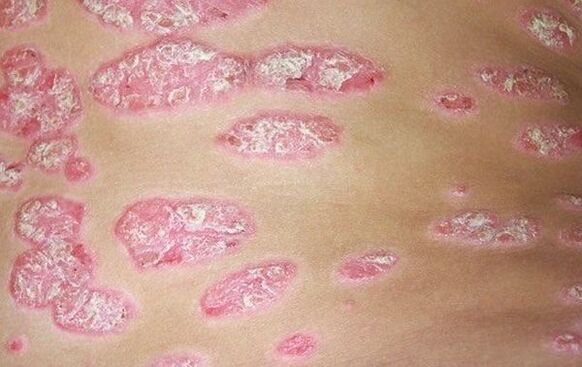
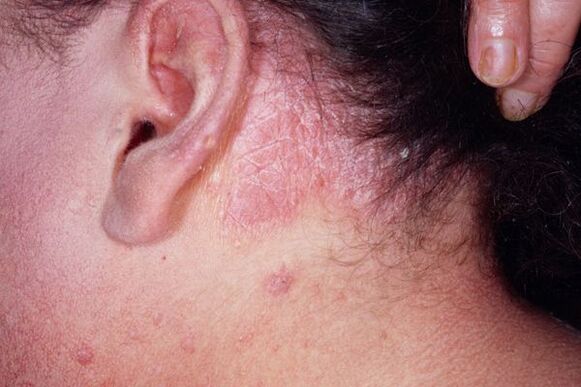
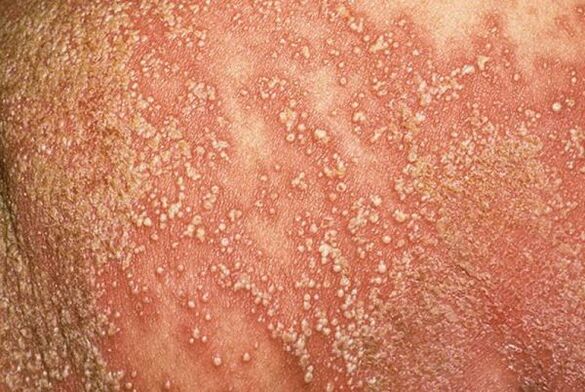
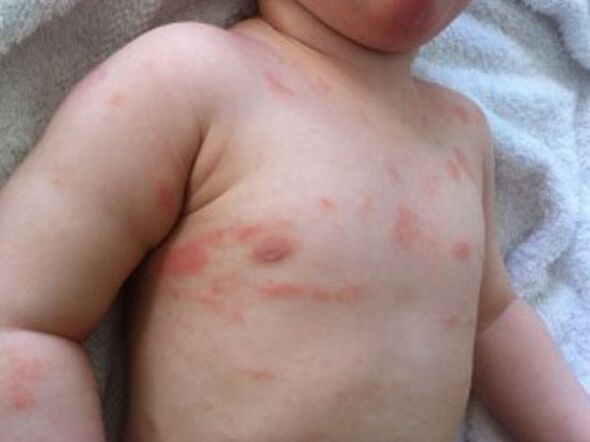
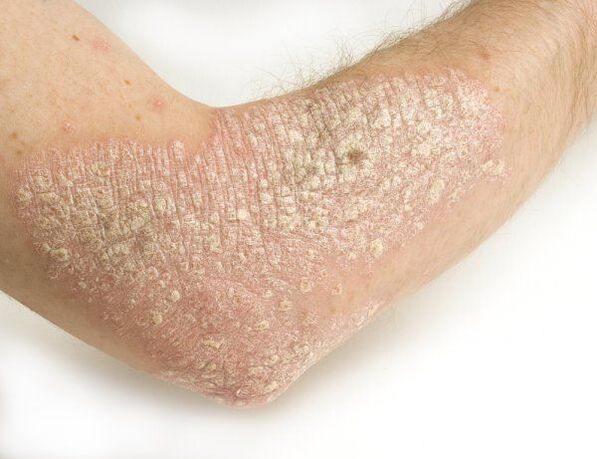
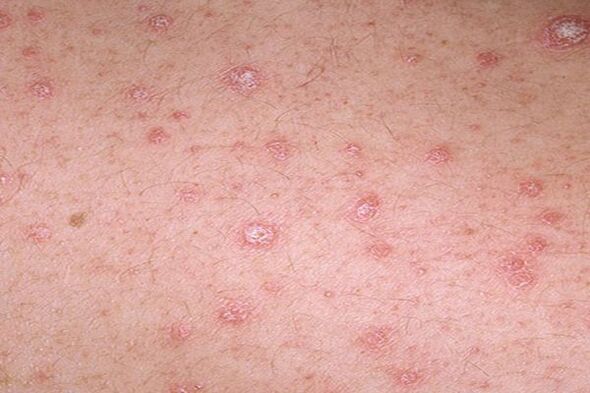
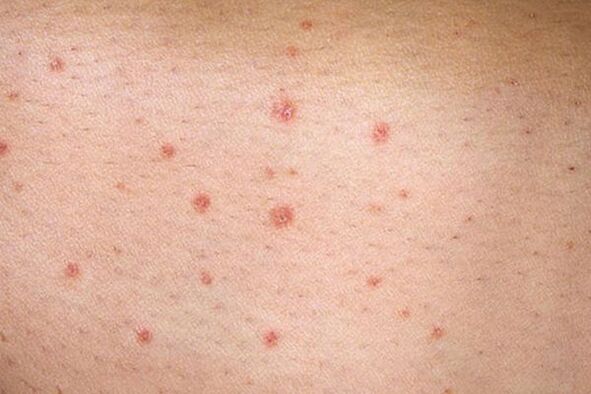
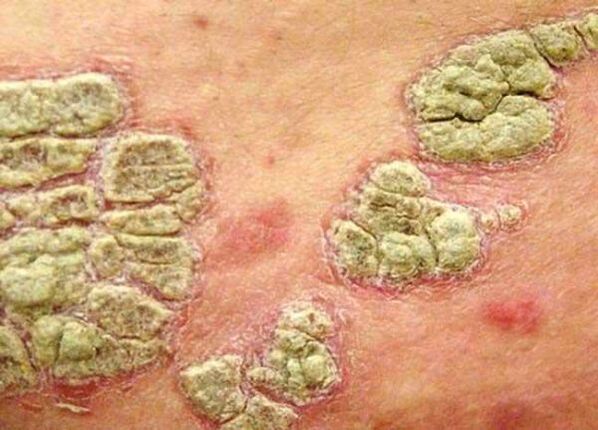

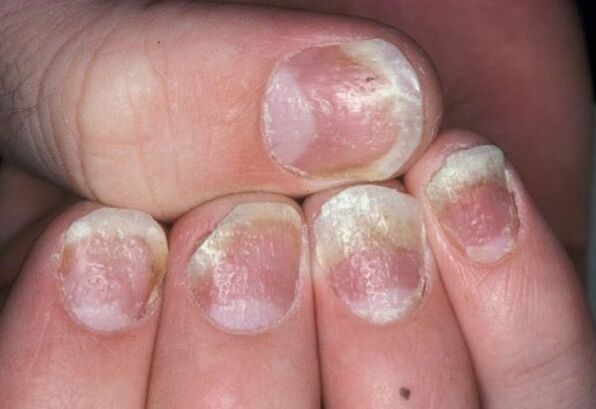
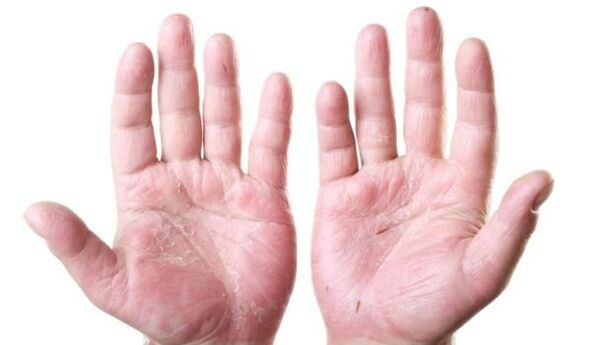
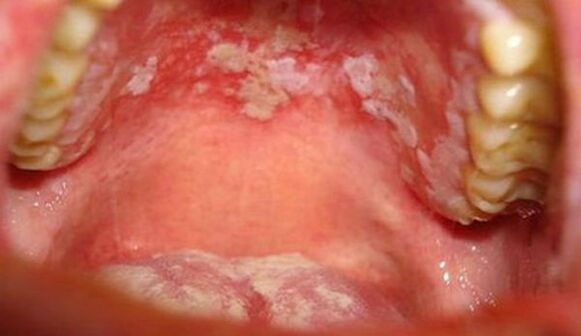
Localization of psoriasis
hands
In most cases, rashes appear on the surface of the elbows or between the toes. Papules on the forearm are less common.
Attention!The hands are distinguished by a plaque form of pathology, but others are also found. Its signs are small spots of a red hue that are quickly covered with white scales and coarsen the affected skin.
legs
Psoriasis formations appear mainly on the legs in the knee area, but it is possible that they form on other parts of the legs.
The first rash is simple and small with a clear outline, but loose, inflamed, and severely scaly. These pinpoint papules spread quickly and form conglomerates.
head
Often develops against the background of seborrhea, affects the hairline and forms the so-called psoriasis crown. Skin formations gradually grow and spread over the entire surface, similar to scales. This localization occurs quite often, less often a rash appears on the ears or behind them.
Fingernails
The nail plate can be affected by the type:
- thimble- Point shape of psoriasis. Small holes appear on the nails that resemble pinprick marks.
- Onychomycosis- The nail becomes discolored, dull, thickened noticeably and begins to peel off. A psoriasis papule is visible through the plate, which is surrounded by a reddish border, similar to an oil stain.
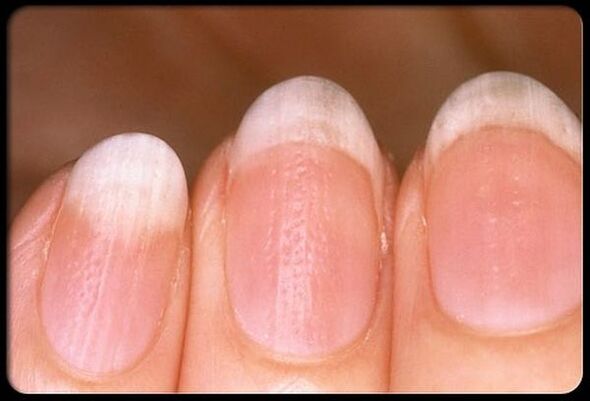
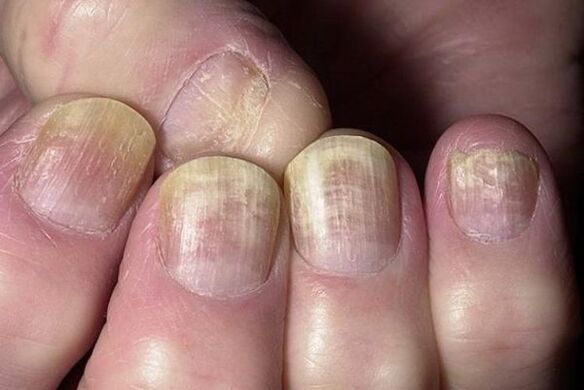
body
Usually manifests itself as characteristic papules that fuse together. Psoriasis occurs more often on the back, less often on the neck, stomach, hips. The formations can be teardrop-shaped, pointed and plaque-like.
face
It is rarely affected, the rash is located in the nasolabial folds in the area of the temples and eyebrows around the eyes. In rare cases, the pathology affects the edge of the lips, the rash resembles herpes.
Palms and feet
Both zones are affected at the same time, but there have been cases when the pathology developed only on the feet or palms. On the soles of the feet, the disease is often combined with a fungal pathology, which makes diagnosis and therapy much more difficult.
This type of psoriasis is divided into 3 types:
- Papular tablet- The formations are dense, do not protrude above the skin, it is difficult to separate the scales from the plaque. The rash appears in the peripheral areas, accompanied by edema and keratosis.
- Psoriatic callus- round dense papules consisting of keratinized epidermis. The layer of skin gradually thickens and coarsens. As a result, it is easily injured, cracks appear. There is practically no reddening, the size of the growths is 2-3 millimeters to 2-3 centimeters.
- Vesicular-pustular- manifests itself in the form of serous-purulent papules. The bubbles reach a diameter of 2 millimeters and tend to combine.
Joints
Pathology can affect a person's joints, causing a change in the structure of their tissues, which, as the action progresses, leads to pain and deformation. External symptoms: a reddish rash appears on the skin. Internal signs - joints ache, especially during sleep, stiffness of movement, swelling is felt.
Important!Psoriasis first affects the small joints of the feet and hands, then spreads to the knees and elbows, and at an advanced stage, the intervertebral joints already suffer.
Itch or not
In most cases, psoriasis is accompanied by itching of varying intensity, sometimes not just spots, but itching all over the body. In the initial stages, the itching is mild and gradually increases.
The degree of intensity also depends on the location of the pathology. For example, psoriasis on the head becomes itchy as the skin peels off and falls off in large flakes that are larger than normal scales. In the stationary stage, the itching decreases and often gives way to a burning sensation. All major symptoms are mild during remission.
Itching worsens with:
- Relapse;
- Climate change;
- general poisoning;
- Digestive tract diseases;
- Accession of scabies, allergies;
- HIV infections.
The skin becomes very itchy after drinking coffee, alcoholic beverages, spicy and spicy foods, chocolate and other allergens.
How to distinguish
For eczema
- The type of rash.In eczema, blisters or blisters become filled with fluid that oozes regularly. Psoriasis is characterized by the appearance of dry scaly papules. When they are removed, blood appears.
- Itchy skin.Due to eczema, the body itches more than with psoriasis pathology.
- Colour.In psoriasis, the scales are silvery in color, and in eczema, the affected areas turn bright red or scarlet.
- Sores.Eczema affects the soft, sensitive areas of the skin, armpits, and groin area. Psoriasis is characterized by a rash on rough, hard, and thick layers of skin (knees, elbows, head, and others).
- The causes of the disease.Psoriasis is often caused by neurogenic factors, and eczema is caused by allergies and body malfunctions.
- Features of rashes on the hands.Psoriasis pits form on the nail plate, and eczema resembles a fungal infection.
For seborrheic dermatitis
The clinical manifestations of the diseases are similar, but there are several features that can be used to distinguish them:
- With psoriasis, an unhealthy glow of the skin and bloody cracks are characteristic, which is not observed with seborrheic dermatitis.
- In contrast to psoriasis, dermatitis is not associated with coarsening of the skin and its severe dryness.
- In psoriasis, the scales are silvery and the seborrhea is yellow or white.
- Seborrheic dandruff is easy to remove, but psoriatic dandruff is not.
- Dermatitis is observed more often in places where the sebum glands accumulate, and on scaly diseases - throughout the body;
- Scalp psoriasis noticeably protrudes beyond the area of hair growth, and seborrheic pathology does not cross this line.
- The area of the squamous cell lesion is much larger than that of dermatitis.
From the mushroom
- Psoriasis occurs in the presence of several provoking factors, such as: B. Heredity, mechanical damage to the skin, malfunction of the immune system, etc. The causative agent of the second disease are only the spores of parasitic fungi.
- Psoriatic pathology is not contagious, it is not transmitted through airborne droplets, nor sexually or through touch.
Attention!The fungus (onychomycosis) affects every contact, including in public places - a sauna, swimming pool, gym, etc. It is transmitted by animals and humans.
- With psoriasis of the head, the structure of the hair does not change, while fungal diseases lead to brittleness, dryness and hair loss.
- Unlike scaly lichen, onychomycosis of the legs and feet is accompanied by an unpleasant odor.
- With the defeat of scaly nails, their structure changes even at the initial stage, and with a fungus, the structure and color of the nail plates do not change for a long time.
Made of pink lichen
The hallmark of psoriasis is the "psoriasis triad". The disease gradually grows and goes through 3 stages. Pityriasis rosea (pityriasis) develops rapidly and is constantly evolving. In addition, pityriasis is a contagious disease, but scaly lichen is not.
From neurodermatitis
- Atopic dermatitis (neurodermatitis) is of allergic origin and is triggered by a certain substance, e. g. B. plant pollen, food, animal hair, etc. The causes of psoriasis are different (heredity, reduced immunity, psychosomatics, mechanical damage to the skin, etc. ).
- With neurodermatitis, the skin dries out and becomes rough, with psoriasis it becomes flaky and bleeds.
- Plaques with dermatitis consist of separate small elements, with shingles, the papules are even and covered with silver scales.
- The color of the rash in psoriasis is much lighter than in eczema.
For gout
The difference between gout and psoriatic arthritis lies in the cause of the development. Gout occurs when uric acid crystals build up in the cartilage of the joints. Deviations from the norm can be provoked by: arterial hypertension, obesity, taking diuretics, drinking alcohol, etc.
The symptoms of psoriasis and gout are similar - severe pain at night, stiffness in movement, redness and swelling in the affected area. However, with psoriasis, in most cases, characteristic red rashes appear first, and then pain.
Other characteristic symptoms of gouty arthritis are:
- the presence of white nodules in the area of the affected joint;
- Signs of kidney stones (back pain, blood in the urine, and others).

























